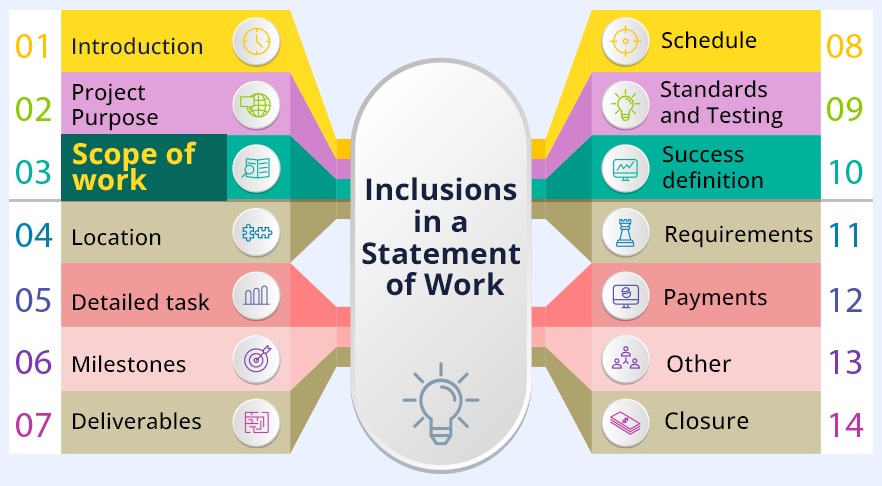
What is the scope of work?
Right off, the scope of work is often confused with the statement of work. There is actually a fine difference between them even if both share the same abbreviation SoW.
Scope of work is a guide to help understand what a project will and will not cover. Normally, a project’s scope of work will be developed by both parties i.e. the Project Manager from the tech partner team and the client. The former is providing a product or service while the latter is contracting the external team for that product or service. That means the Scope of Work needs contribution from both sides. The document usually covers project needs and how the project goals will be achieved. It will also contain details of how the team will provide deliverables, milestones, timelines and reports.
From the above, it is understood the scope of work is a vital agreement to sign off on before actual work starts. Some companies stop with this but many will also require a legally binding document between the client and vendor or contractor. The scope of work then becomes a subset of a larger legal document known as the statement of work. It is typically drafted by the client’s side at the very start of the project and adds to the scope of work. It defines the project objectives, project cost, and schedules.

How to outline a high-level scope of work?
Your tech partner wants to do the best job possible. To make that happen you need to make your expectations clear at the start. Outlining the requirements for the project before you even get into the initial discussions with your IT outsourcing partner will ensure there is no room for miscommunication. A clear, initial scope of work provides these benefits:
- Help the IT outsourcing companies to provide a fair cost estimate.
- Ensure that all requirements for the project are clearly laid out with deliverables.
- Help to get the team together with the right technical expertise.
Here is what the initial scope of work document should cover that will be the basis for a more exhaustive document by the tech partner once the initial selection is made. It should detail
1) The expected budget for your project
2) The services that the vendor should provide
3) Division of work between the two
4) Time to complete the project
5) The technologies you want to use
A lot of factors go into how much a project will cost, including the number of people and the skill sets you need to complete the project within your timeline. If a vendor quotes more than your budget then that might rule them out or you might need to adjust your budget.
When creating the scope of work, under the project description, include all the ‘must haves’ as well as the ‘good to haves’. This should be an extensive list, including all the product features, and the tech stack to be used. This will be a good guide for an IT outsourcing company who are evaluating your project, to know if they have the expertise needed as well as be able to provide you with better strategies to improve the output. For instance, consider this scenario – you want to develop an android app and are evaluating two different IT outsourcing service providers. Company X is quoting a price that fits your budget but they only have 2 Android app developers to assign to your project and they would take 4 months more than your expected timeline. Company Z, on the other hand, has a team of Android developers and can meet your timeline but is quoting 30% more than the budget you have stipulated. In such a case, your organization will have to decide whether meeting the timeline is more important than the budget or the other way around.
Final thoughts on writing the SoW
Writing a scope of work document requires many stakeholders on the client side to collaborate to avoid any misunderstanding later. The initial scope of work will give the right direction for the service provider to build on. You might also need to rope in the help of a technical writer and as already mentioned you might need to get your legal team in if you extend it into a statement of work. That said, here are a few tips to make your scope of work effective:
- Keep it brief: While covering the important details is a prerequisite, writing a 40-page document might be counterproductive. This would mean that your service provider would need to go through it line by line and it would probably slow down the process, if not confuse them.
- Start early: Don’t wait till the end to write the SoW because starting early even before you start looking for outsourced IT services means that you will have time for your document to take shape.
- Include a problem statement: This is of particular importance in process improvement projects. A problem statement is a concise description of the current state, the future state and the gap between the two. It will help to guide the activities as well as the decisions of the team working on the project.
There you have it! Whether building an app, an EHR healthcare solution or automating workflows or even switching tech vendors, the SoW is most important. From our experience working as the technology service provider for businesses across the globe, a well-thought-out scope of work will keep everyone on track and accountable.
Not sure where to start your project? Connect with our team of experts and we will be glad to help you get started.






